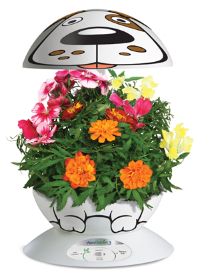
Who knew dirt-free indoor garden kits could be such a hot commodity? They’re also a great direct marketing product, which is why AeroGrow International is shifting its business model away from selling to retailers and targeting consumers directly.
“We’re squarely on the right side of a lot of emerging and powerful trends,” says J. Michael Wolfe, the company’s chief operating officer.
“Our product is healthy, it’s green, it’s renewable and it assures fresh, safe food.” It can also save consumers money, he says, in, that a $50 AeroGarden will produce hundreds of dollars worth of herbs.
So why not just keep selling through retailers? AeroGrow has in a relatively short time built up a powerful database. Wolfe, who has been in the direct marketing industry for 25 years, says he’s “never seen a customer database that performs as well as this one does.”
AeroGrow’s direct-mail-acquired customers perform better than those from any other source available, Wolfe says. “They are among the least costly customers to bring onto the database, and they have the best back-end performance — with high repeat purchase frequency and multiyear value,” he says.
The company announced the intended shift in its business model in January, when it named Jack J. Walker CEO, replacing Jerry Perkins, AeroGrow’s CEO since March 2008. (Perkins will continue to serve on the board of directors.)
That’s also when Wolfe, who had been vice president of operations since April 2006, was promoted to his current position. He’d also served as the general manager of AeroGrow’s direct response division since August 2008, and launched the company’s first direct response catalog in 2007.
AeroGrow’s targeted prospecting efforts — largely through its catalogs — have brought “a better quality of name onto our database, significantly increasing the lifetime value of a name on our database,” Wolfe says.
Green and mean
Boulder, CO-based AeroGrow International was founded in 2002, and currently employs about 40 people. It became a publicly traded company in 2006, the same year it launched its core product.
That would be the AeroGarden, which uses dirt-free aeroponic technology to create a humid growing chamber that fits on a kitchen counter. The fast-growing, “high-output” indoor garden produces fresh herbs, vegetables and flowers year-round. And customers return to buy more seed kits every four months or so.
Indeed, the big win in AeroGrow’s business model is in the “annuity” that it sells in the form of seed kits, grow bulbs and so on, Wolfe says. “This part of the product line has the highest margins.”
AeroGrow sells more than 50 seed kits in its line now, and the line is constantly growing, Wolfe says. “Soon, we hope to be selling many more vegetables and flowers.”
The company started out selling via stores, on Websites and in catalogs such as Frontgate and Herrington, as well as through television via QVC and infomercials. But working with large retailers has become increasingly difficult since the economy plummeted in fall 2008, Wolfe says.
“Since then, we have found that more retailers are pushing the inventory risk back to the manufacturers — often placing purchase orders for products and then not taking delivery of them,” Wolfe says. “As a relatively young company, this risk has just proved to be too onerous.”
AeroGrow will continue to partner with Amazon.com, QVC and some other retailers, Wolfe says. “But our direct business affords us significantly higher gross margins than those we traditionally achieved in our retail business.”
AeroGrow’s channel shift is not uncommon these days, says David Solomon, co-CEO of investment firm Lazard Middle Market. More manufacturers are braving the channel conflict caused by competing directly with their retail clients and by selling direct to the consumer.
“The implications for higher margins and better inventory control can offset the loss of wholesale business,” Solomon says.
What’s more, the direct model allows the company to sustain an ongoing relationship with its customers.
“In an annuity business such as AeroGrow’s, where the lifetime value of the buyer is so important, we feel that having a direct relationship with our customer is a powerful opportunity,” Wolfe says.
A direct path
Before joining AeroGrow, Wolfe had been president/chief operating officer of Concepts Direct, where he oversaw the development, launch and operations of seven independent catalogs, including the Colorful Images, Snoopy, Etc. and Linda Anderson brands. Revenue grew to more than $80 million prior to the sale of the company to Taylor Corp.
Prior to that, Wolfe served as vice president of database management company Wiland Services, which had launched Colorful Images. (When Wiland Services was sold to NeoData Corp., the assets related to Colorful Images were spun off to Wiland’s shareholders and became Concepts Direct.)
So how did Wolfe wind up at AeroGrow?
“I met Michael Bissonnette, AeroGrow’s founder, in 2005 and I loved the business model,” Wolfe recalls. As funny as it sounds, he notes, “there are a lot of similarities between selling stationery products through Colorful Images and seed kits at AeroGrow: Both are basically annuity businesses in which building a rich customer database that will continue ordering from you is the key.”
Since December 2008, Wolfe has spearheaded AeroGrow’s overhaul of its Internet division. “I would characterize this as a shift from top-line focus to bottom-line focus in our marketing initiatives,” Wolfe explains.
During that period, the return on media dollars spent in the company’s direct response business more than doubled and its database of active buyers surpassed 100,000 names — a growth rate of over 15%.
Better still, the average annual amount spent by existing AeroGrow customers in repeat purchases increased by more than 20%, to nearly $50.
How did it do this? Specifically, AeroGrow restructured its pay per click (PPC) and affiliate programs to bring media costs into line and ensure that they were generating profitable revenue.
The company also put a greater emphasis on the quality of its e-newsletter, “which dramatically increased the frequency with which we contacted our e-newsletter subscribers. This turned our e-newsletter from an afterthought into a primary marketing vehicle to our customers,” Wolfe says.
AeroGrow also shifted a large portion of its media expenditures from infomercials to catalog prospecting. This enables it to generate customers at a much lower acquisition cost, but also captures a customer with a far superior lifetime value.
“Two years ago we spent over $85 per new name that we added to the database,” Wolfe explains. “This number improved to $20 per name in the most recent 12-month period.”
Wolfe says AeroGrow’s total database has grown about 50% and the active customer file rose by 15%. During that time, he notes, sales to prospects actually decreased, “as we spent significantly fewer media dollars on television advertising and had a reduced retail presence.”
As a result, total sales declined somewhat, he says, “but we reduced our cost for customer acquisition dramatically, which has set the stage for sustainable profitability.”
Next Page: A bumper crop of new product ideas
AeroGrow forecast a near-breakeven EBITDA for the quarter ended Dec. 31, marking a big improvement from last year’s $3.7 million EBITDA loss in the same period. For the fiscal years 2007, 2008 and 2009, AeroGrow recorded sales of $13.1 million $38.4 million, and $37.4 million, respectively. Net losses for those same years were $10.1 million, $9.8 million and $10.3 million.
While AeroGrow saw a modest decline in overall revenue due to more targeted prospecting efforts, there were encouraging increases in several other segments: Sales to existing customers increased by over 30%; repeat purchases over the Web were up 62%; and the e-newsletter saw an increase in sales of 155% with the same media cost.
What’s more, the portion of total sales taken over the Web — a low-cost order-taking vehicle — has increased from 30% in 2007 to 49% in 2008 and to 77% in 2009.
Catalogs key to growth
AeroGrow mailed more than 50,000 copies of its first catalog in June 2007. The company found that a 16-page prospect catalog was as effective as a 32-page prospect catalog, Wolfe says. “So the lower cost per catalog allowed us to increase our total prospect circulation, contributing to the 15% growth in the database.”
AeroGrow produces the catalog inhouse. “One great thing about being headquartered in Boulder, CO, is all of the outstanding creative people who live here,” Wolfe says. “That and a strong local direct marketing community has allowed us to build a strong inhouse team of direct marketers.”
Wolfe has extensive experience with catalogs, having worked with mailers such as Lillian Vernon, Dell and Williams-Sonoma while at Wiland Services. How will AeroGrow’s emphasis on its direct division affect the role of its print catalog? “We have always measured our catalog as a pure direct response vehicle, and we always will,” he says.
“That being said, we’re more mindful than ever about the interactive effect of our media,” he notes. “We’re certain that some portion of the success of our e-newsletter and our other Web marketing programs is driven by the fact that the customer also receives a catalog.”
Expanding the line

Another key strategy for AeroGrow is improving its product offering, Wolfe says. “In addition to extending the line of prepackaged seed kits we offer to our customers, we also introduced custom seed kits last year.”
These kits allow customers to choose from a broad selection of herbs or flowers so they can grow exactly what they want in their AeroGardens. “The custom seed kits immediately became our best-selling seed kits and led to an increase in total seed kit sales to existing customers,” Wolfe says.
After conducting extensive testing during 2009, the company on Jan. 1 lowered all of its prices to the new “everyday low pricing” model. For example, the prices on the AeroGarden 3 (three-pod) went from $79.75 to $49.95, the AeroGarden 6 went from $129.95 to $79.95, and so on.
“We think this has clearly led to improved customer involvement with demand offsetting and exceeding the impact of pricing reductions,” Wolfe says.
But is AeroGrow’s niche too narrow for product development? Not at all, according to Wolfe. “We’ve sold nearly 1 million AeroGardens to date to — we think — about 700,000 independent households,” he says.
He believes AeroGrow’s product can achieve a minimum of 10% U.S. household penetration. Given that AeroGrow is now at about one-half of 1% household penetration, Wolfe notes, “we feel like we have a lot of runway with the product.”
A bumper crop of new product ideas

You might think AeroGrow International would have a hard time expanding beyond its kitchen counter garden roots. But its chief operating officer, J. Michael Wolfe, is not worried about that. “From a garden standpoint, look for us to extend our technology into other spaces in the home and office,” he says.
For example, AeroGrow has recently test-marketed a version of its AeroGarden that also serves as a desk lamp that emits fresh flower scents. “It tested higher than any product we’ve ever developed,” Wolfe says.
The company also aims to aggressively grow its accessories product line. “We’ve had very good success selling products like herb shears and salad dressing makers,” Wolfe says. It plans to add about 70 accessory SKUs this year — about half of which will be branded under the AeroGarden name.
AeroGrow is already seeing strong results in expanding the core line to appeal to niche markets, for instance, an AeroGarden designed in the likeness of a dog or a cat, Wolfe says. “The best-selling item in our line is a garden that looks like a Lady Bug.
—JT